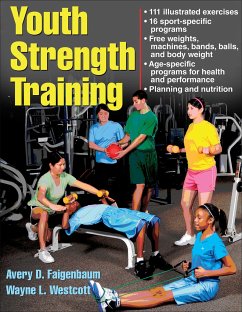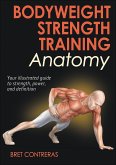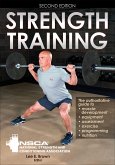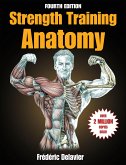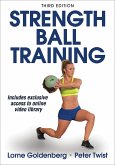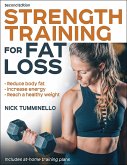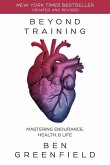- Broschiertes Buch
- Merkliste
- Auf die Merkliste
- Bewerten Bewerten
- Teilen
- Produkt teilen
- Produkterinnerung
- Produkterinnerung
The e-book format allows readers to bookmark, highlight, and take notes throughout the text. When purchased through the HK site, access to the e-book is immediately granted when your order is received.
Andere Kunden interessierten sich auch für
![Bodyweight Strength Training Anatomy Bodyweight Strength Training Anatomy]() Bret ContrerasBodyweight Strength Training Anatomy27,99 €
Bret ContrerasBodyweight Strength Training Anatomy27,99 €![Strength Training Strength Training]() Strength Training25,99 €
Strength Training25,99 €![Strength Training Anatomy Strength Training Anatomy]() Frederic DelavierStrength Training Anatomy33,99 €
Frederic DelavierStrength Training Anatomy33,99 €![Strength Ball Training Strength Ball Training]() Lorne GoldenbergStrength Ball Training22,99 €
Lorne GoldenbergStrength Ball Training22,99 €![Strength Training for Fat Loss Strength Training for Fat Loss]() Nick TumminelloStrength Training for Fat Loss29,99 €
Nick TumminelloStrength Training for Fat Loss29,99 €![Grow Wild Grow Wild]() Katy BowmanGrow Wild31,99 €
Katy BowmanGrow Wild31,99 €![Beyond Training Beyond Training]() Ben GreenfieldBeyond Training30,99 €
Ben GreenfieldBeyond Training30,99 €-
-
-
The e-book format allows readers to bookmark, highlight, and take notes throughout the text. When purchased through the HK site, access to the e-book is immediately granted when your order is received.
Hinweis: Dieser Artikel kann nur an eine deutsche Lieferadresse ausgeliefert werden.
Hinweis: Dieser Artikel kann nur an eine deutsche Lieferadresse ausgeliefert werden.
Produktdetails
- Produktdetails
- Verlag: Human Kinetics Publishers
- Seitenzahl: 248
- Erscheinungstermin: 18. August 2009
- Englisch
- Abmessung: 282mm x 215mm x 22mm
- Gewicht: 718g
- ISBN-13: 9780736067928
- ISBN-10: 0736067922
- Artikelnr.: 26516481
- Herstellerkennzeichnung
- Libri GmbH
- Europaallee 1
- 36244 Bad Hersfeld
- 06621 890
- Verlag: Human Kinetics Publishers
- Seitenzahl: 248
- Erscheinungstermin: 18. August 2009
- Englisch
- Abmessung: 282mm x 215mm x 22mm
- Gewicht: 718g
- ISBN-13: 9780736067928
- ISBN-10: 0736067922
- Artikelnr.: 26516481
- Herstellerkennzeichnung
- Libri GmbH
- Europaallee 1
- 36244 Bad Hersfeld
- 06621 890
Avery D. Faigenbaum, EdD,CSCS, is a professor in the department of health and exercise science at the College of New Jersey. Dr. Faigenbaum is a leading researcher and practitioner in pediatric exercise science, with nearly 20 years of experience in working with children and adolescents. He has authored more than 100 scientific articles, 20 book chapters, and 7 books related to youth fitness and conditioning. In addition, Dr. Faigenbaum has lectured nationally and internationally to health and fitness organizations and has developed youth fitness programs for YMCAs, recreation centers, physical education classes, and after-school sport programs. Dr. Faigenbaum is a fellow of the AmericanCollege of Sports Medicine and of the National Strength and Conditioning Association. He is also a member of the International Scientific Advisory Committee and was a member of the Massachusetts Governor's Council on Physical Fitness and Sports for 7 years. Wayne L. Westcott, PhD, CSCS, is a fitness research director at the South Shore YMCA and adjunct instructor of exercise science at QuincyCollege, both in Quincy, Massachusetts. He has served as a strength-training consultant for Nautilus, the United States Navy, the American Council on Exercise, the President's Council on Physical Fitness and Sports, and the YMCA of the USA. He has also been an editorial advisor for many publications, including Physician and Sportsmedicine, Fitness Management, On-Site Fitness, Prevention, Shape, and Men's Health. He has authored or coauthored 23 books on youth strength training worldwide and has helped numerous colleges, schools, YMCAs, and fitness centers develop youth strength-training programs.
Foreword
Acknowledgments
Introduction
Part I Fitness Fundamentals
Chapter 1. Ready to Train
Strength Training Versus Weightlifting, Powerlifting, and Bodybuilding
FUNdamental Fitness
Muscles, Bones, and Connective Tissue
Program Assessment
Getting Ready
Summary
Chapter 2. Program Prescriptions
Training Guidelines
Program Considerations
Play Education
Summary
Chapter 3. Exercise Technique and Training Procedures
Understanding Children
Being a Teacher
Developing the Fitness Workout
Using Equipment Safely
Keeping It Progressive
Summary
Part II Exercises
Chapter 4. Free Weights
Training With Free Weights
Free-Weight Exercises
Summary
Chapter 5. Weight Machines
Training on Weight Machines
Weight Machine Exercises
Summary
Chapter 6. Elastic Bands and Medicine Balls
Training With Elastic Bands and Medicine Balls
Elastic Band Exercises
Medicine Ball Exercises
Summary
Chapter 7. Body-Weight Training
Using Body Weight as Resistance
Body-Weight Exercises
Summary
Part III Program Design
Chapter 8. General Preparation
Preparatory Conditioning
Training Youth
Dynamic Motivation
Summary
Chapter 9. Basic Strength and Power for Ages 7 to 10
Components of the Warm-Up and Cool-Down
Strength-Training Program
Strength-Training Exercises
Training Considerations
Summary
Chapter 10. Intermediate Strength and Power for Ages 11 to 14
Components of the Warm-Up and Cool-Down
Strength-Training Program
Machine Strength-Training Exercises
Medicine Ball Strength-Training Exercises
Training Considerations
Summary
Chapter 11. Advanced Strength and Power for Ages 15 to 18
Components of the Warm-Up and Cool-Down
Strength-Training Program
Machine and Free-Weight Strength-Training Exercises
Medicine Ball and Elastic Band Strength-Training Exercises
Training Considerations
Summary
Chapter 12. Sport-Specific Power and Strength for Young Athletes
Training for Sport Conditioning
Baseball and Softball
Basketball and Volleyball
Dancing and Figure Skating
Football and Rugby
Ice Hockey and Field Hockey
Soccer
Swimming
Tennis
Track: Sprints and Jumps
Track: Distance Running
Summary
Part IV Long-Term Planning and Nutritional Support
Chapter 13. Periodization and Recovery
Overreaching and Overtraining
Models of Periodization
Rest and Recovery
Long-Term Development
Summary
Chapter 14. Eating for Strength and Performance
Basics of Healthy Eating
Children's Nutritional Needs
Hydration
Snack Foods
Summary
Appendix A: Sample Workout Log
Appendix B: Suggested Readings
Index
About the Authors
Acknowledgments
Introduction
Part I Fitness Fundamentals
Chapter 1. Ready to Train
Strength Training Versus Weightlifting, Powerlifting, and Bodybuilding
FUNdamental Fitness
Muscles, Bones, and Connective Tissue
Program Assessment
Getting Ready
Summary
Chapter 2. Program Prescriptions
Training Guidelines
Program Considerations
Play Education
Summary
Chapter 3. Exercise Technique and Training Procedures
Understanding Children
Being a Teacher
Developing the Fitness Workout
Using Equipment Safely
Keeping It Progressive
Summary
Part II Exercises
Chapter 4. Free Weights
Training With Free Weights
Free-Weight Exercises
Summary
Chapter 5. Weight Machines
Training on Weight Machines
Weight Machine Exercises
Summary
Chapter 6. Elastic Bands and Medicine Balls
Training With Elastic Bands and Medicine Balls
Elastic Band Exercises
Medicine Ball Exercises
Summary
Chapter 7. Body-Weight Training
Using Body Weight as Resistance
Body-Weight Exercises
Summary
Part III Program Design
Chapter 8. General Preparation
Preparatory Conditioning
Training Youth
Dynamic Motivation
Summary
Chapter 9. Basic Strength and Power for Ages 7 to 10
Components of the Warm-Up and Cool-Down
Strength-Training Program
Strength-Training Exercises
Training Considerations
Summary
Chapter 10. Intermediate Strength and Power for Ages 11 to 14
Components of the Warm-Up and Cool-Down
Strength-Training Program
Machine Strength-Training Exercises
Medicine Ball Strength-Training Exercises
Training Considerations
Summary
Chapter 11. Advanced Strength and Power for Ages 15 to 18
Components of the Warm-Up and Cool-Down
Strength-Training Program
Machine and Free-Weight Strength-Training Exercises
Medicine Ball and Elastic Band Strength-Training Exercises
Training Considerations
Summary
Chapter 12. Sport-Specific Power and Strength for Young Athletes
Training for Sport Conditioning
Baseball and Softball
Basketball and Volleyball
Dancing and Figure Skating
Football and Rugby
Ice Hockey and Field Hockey
Soccer
Swimming
Tennis
Track: Sprints and Jumps
Track: Distance Running
Summary
Part IV Long-Term Planning and Nutritional Support
Chapter 13. Periodization and Recovery
Overreaching and Overtraining
Models of Periodization
Rest and Recovery
Long-Term Development
Summary
Chapter 14. Eating for Strength and Performance
Basics of Healthy Eating
Children's Nutritional Needs
Hydration
Snack Foods
Summary
Appendix A: Sample Workout Log
Appendix B: Suggested Readings
Index
About the Authors
Foreword
Acknowledgments
Introduction
Part I Fitness Fundamentals
Chapter 1. Ready to Train
Strength Training Versus Weightlifting, Powerlifting, and Bodybuilding
FUNdamental Fitness
Muscles, Bones, and Connective Tissue
Program Assessment
Getting Ready
Summary
Chapter 2. Program Prescriptions
Training Guidelines
Program Considerations
Play Education
Summary
Chapter 3. Exercise Technique and Training Procedures
Understanding Children
Being a Teacher
Developing the Fitness Workout
Using Equipment Safely
Keeping It Progressive
Summary
Part II Exercises
Chapter 4. Free Weights
Training With Free Weights
Free-Weight Exercises
Summary
Chapter 5. Weight Machines
Training on Weight Machines
Weight Machine Exercises
Summary
Chapter 6. Elastic Bands and Medicine Balls
Training With Elastic Bands and Medicine Balls
Elastic Band Exercises
Medicine Ball Exercises
Summary
Chapter 7. Body-Weight Training
Using Body Weight as Resistance
Body-Weight Exercises
Summary
Part III Program Design
Chapter 8. General Preparation
Preparatory Conditioning
Training Youth
Dynamic Motivation
Summary
Chapter 9. Basic Strength and Power for Ages 7 to 10
Components of the Warm-Up and Cool-Down
Strength-Training Program
Strength-Training Exercises
Training Considerations
Summary
Chapter 10. Intermediate Strength and Power for Ages 11 to 14
Components of the Warm-Up and Cool-Down
Strength-Training Program
Machine Strength-Training Exercises
Medicine Ball Strength-Training Exercises
Training Considerations
Summary
Chapter 11. Advanced Strength and Power for Ages 15 to 18
Components of the Warm-Up and Cool-Down
Strength-Training Program
Machine and Free-Weight Strength-Training Exercises
Medicine Ball and Elastic Band Strength-Training Exercises
Training Considerations
Summary
Chapter 12. Sport-Specific Power and Strength for Young Athletes
Training for Sport Conditioning
Baseball and Softball
Basketball and Volleyball
Dancing and Figure Skating
Football and Rugby
Ice Hockey and Field Hockey
Soccer
Swimming
Tennis
Track: Sprints and Jumps
Track: Distance Running
Summary
Part IV Long-Term Planning and Nutritional Support
Chapter 13. Periodization and Recovery
Overreaching and Overtraining
Models of Periodization
Rest and Recovery
Long-Term Development
Summary
Chapter 14. Eating for Strength and Performance
Basics of Healthy Eating
Children's Nutritional Needs
Hydration
Snack Foods
Summary
Appendix A: Sample Workout Log
Appendix B: Suggested Readings
Index
About the Authors
Acknowledgments
Introduction
Part I Fitness Fundamentals
Chapter 1. Ready to Train
Strength Training Versus Weightlifting, Powerlifting, and Bodybuilding
FUNdamental Fitness
Muscles, Bones, and Connective Tissue
Program Assessment
Getting Ready
Summary
Chapter 2. Program Prescriptions
Training Guidelines
Program Considerations
Play Education
Summary
Chapter 3. Exercise Technique and Training Procedures
Understanding Children
Being a Teacher
Developing the Fitness Workout
Using Equipment Safely
Keeping It Progressive
Summary
Part II Exercises
Chapter 4. Free Weights
Training With Free Weights
Free-Weight Exercises
Summary
Chapter 5. Weight Machines
Training on Weight Machines
Weight Machine Exercises
Summary
Chapter 6. Elastic Bands and Medicine Balls
Training With Elastic Bands and Medicine Balls
Elastic Band Exercises
Medicine Ball Exercises
Summary
Chapter 7. Body-Weight Training
Using Body Weight as Resistance
Body-Weight Exercises
Summary
Part III Program Design
Chapter 8. General Preparation
Preparatory Conditioning
Training Youth
Dynamic Motivation
Summary
Chapter 9. Basic Strength and Power for Ages 7 to 10
Components of the Warm-Up and Cool-Down
Strength-Training Program
Strength-Training Exercises
Training Considerations
Summary
Chapter 10. Intermediate Strength and Power for Ages 11 to 14
Components of the Warm-Up and Cool-Down
Strength-Training Program
Machine Strength-Training Exercises
Medicine Ball Strength-Training Exercises
Training Considerations
Summary
Chapter 11. Advanced Strength and Power for Ages 15 to 18
Components of the Warm-Up and Cool-Down
Strength-Training Program
Machine and Free-Weight Strength-Training Exercises
Medicine Ball and Elastic Band Strength-Training Exercises
Training Considerations
Summary
Chapter 12. Sport-Specific Power and Strength for Young Athletes
Training for Sport Conditioning
Baseball and Softball
Basketball and Volleyball
Dancing and Figure Skating
Football and Rugby
Ice Hockey and Field Hockey
Soccer
Swimming
Tennis
Track: Sprints and Jumps
Track: Distance Running
Summary
Part IV Long-Term Planning and Nutritional Support
Chapter 13. Periodization and Recovery
Overreaching and Overtraining
Models of Periodization
Rest and Recovery
Long-Term Development
Summary
Chapter 14. Eating for Strength and Performance
Basics of Healthy Eating
Children's Nutritional Needs
Hydration
Snack Foods
Summary
Appendix A: Sample Workout Log
Appendix B: Suggested Readings
Index
About the Authors

